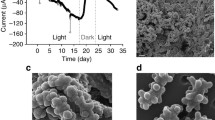Abstract
Respiring cells of the chemolithotrophic bacterium Thiomicrospira crunogena produced sulfur globules from the sulfane sulfur of thiosulfate below pH 7, and consumed the globules above pH 7. The switch in metabolism was immediate and reversible upon titration of the culture. The consumed sulfur globules remained in a membrane-bound form and were not oxidized unless the medium was depleted of thiosulfate. Sulfur globule production but not uptake was blocked by azide. Anoxia, thiol-binding agents, and inhibitors of protein synthesis blocked globule uptake. Transitory accumulations of sulfite and polythionates appeared to be reaction products of thiosulfate and sulfur globules. A model depicting the pH sensitivity and biochemistry of sulfur globule production and consumption is proposed.
Similar content being viewed by others
References
Adair FW (1966) Membrane-associated sulfur oxidation by the autotroph Thiobacillus thiooxidans. J Bacteriol 92:899–904
Aminuddin M, Nicholas DJD (1973) Sulphide oxidation linked to the reduction of nitrate and nitrite in Thiobacillus denitrificans. Biochem Biophys Acta 325:81–93
Charles AM, Suzuki I (1966) Mechanism of thiosulfate oxidation by Thiobacillus novellum. Biochem Biophys Acta 128:510–521
Chen KY, Morris JC (1972) Kinetics of oxidation of aqueous sulfide by O2. Environ Sci Technol 6:529–537
Fahey RC, Newton GL (1987) Determination of low-molecular-weight thiols using monobromobimane fluorescent labeling and high-performance liquid chromatography. In: Jacoby WB, Griffith OW (eds) Methods in enzymology, vol 143: Sulfur and sulfur amino acids. Academic Press, New York, pp 85–95
Hazeu W, Batenburg-van der Vegte WH, Bos P, van der Pas RK, Kuenen JG (1988) The production and utilization of intermediary elemental sulfur during the oxidation of reduced sulfur compounds by Thiobacillus ferrooxidans. Arch Microbiol 150: 574–579
Jannasch HW, Wirsen CO, Nelson DC, Robertson LA (1985) Thiomicrospira crunogena sp. nov., a colorless, sulfur-oxidizing bacterium from a deep-sea hydrothermal vent. Int J Syst Bacteriol 35:422–424
Jones GE, Benson AA (1964) Phosphatidyl glycerol in Thiobacillus thiooxidans. J Bacteriol 89:260–261
Kelly DP (1982) Biochemistry of the chemolithotrophic oxidation of inorganic sulphur. Philos Trans R Soc Lond B 298:499–528
Kelly DP (1988) Oxidation of sulphur compounds. In: Cole JA, Ferguson SJ (eds) Nitrogen and sulfur cycles. Cambridge University Press, Cambridge. pp 65–97
Kelly DP, Harrison AP (1989) Genus Thiobacillus Beijerinck 1904b, 597AL. In: Staley JT (ed) Bergey's manual of systematic bacteriology, vol 3. Williams and Wilkins, Baltimore, pp 1842–1858
Kelly DP, Chambers LA, Trudinger PA (1963) Cyanolysis and spectrophotometric estimation of trithionate in a mixture with thiosulfate and tetrathionate. Anal Chem 41:898–901
Kuenen JG, Veldkamp H (1972) Thiomicrospira pelophila, gen. n., sp. n., a new obligately chemolithotrophic colourless sulfur bacterium. Antonie van Leewenhoek J Microbiol Serol 38: 241–256
Kuenen JG, Robertson LA (1989) Genus Thiomicrospira Kuenen and Veldkamp 1972, 253AL. In: Staley JT (ed) Bergey's manual of systematic bacteriology, vol 3. Williams and Wilkins, Baltimore, pp 1858–1861
Lees H (1960) Energy metabolism in chemolithotrophic bacteria. Annu Rev Microbiol 14:83–98
Moriarty DJW, Nicholas DJD (1970) Products of sulphide oxidation in extracts of Thiobacillus concretivorus. Biochim Biophys Acta 197:143–151
Nelson DC, Jannasch HW (1983) Chemoautotrophic growth of a marine Beggiatoa in sulfide-gradient cultures. Arch Microbiol 136:262–269
O'Brien DJ, Birkner FB (1977) Kinetics of oxygenation of reduced sulfur species in aqueous solution. Environ Sci Technol 11:1114–1120
Revsbech NP, Jørgensen BB, Blackburn TH, Cohen Y (1983) Microelectrode studies of the photosynthesis and O2, H2S and pH profiles of a microbial mat. Limnol Oceanogr 28:1062–1074
Ruby EG, Jannasch HW (1982) Physiological characteristics of Thiomicrospira sp. strain L-12 isolated from deep-sea hydrothermal vents. J Bacteriol 149:161–165
Ruby EG, Wirsen CO, Jannasch HW (1981) Chemolithothrophic sulfur-oxidizing bacteria from the Galapagos Rift hydrothermal vents. Appl Environ Microbiol 42:317–324
Schedel M, Trüper HG (1980) Anaerobic oxidation of thiosulfate and elemental sulfur in Thiobacillus denitrificans. Arch Microbiol 124:205–210
Schmidt M (1965) Reactions of the sulfur-sulfur bond. In: Meyer B (ed) Elemental sulfur. Chemistry and physics. Interscience, New York, pp 301–326
Schmidt TM, Vinci VA, Strohl WR (1986) Protein synthesis by Beggiatoa alba B18LD in the presence and absence of sulfide. Arch Microbiol 144:158–162
Smith AJ (1966) The role of tetrathionate in the oxidation of thiosulphate by Chromatium sp. strain D. J Gen Microbiol 42:371–380
Sörbo B (1957) A colorimetric method for the determination of thiosulfate. Biochim Biophys Acta 23:416–421
Steudel R (1989) On the nature of the “elemental sulfur” (S°) produced by sulfur-oxidization bacteria — a model for S° globules. In: Schlegel HG, Bowien B (eds) Autotrophic bacteria. Science Tech Publishers, Madison, pp 289–303
Steudel R, Holdt G, Gobel T, Hazeu W (1987) Chromatographic separation of higher polythionates SxO 2-6 (n=3–22) and their detection in cultures of Thiobacillus ferrooxidans; molecular composition of bacterial sulfur secretions. Angew Chem, Int Ed Engl 26:151–153
Steudel R, Gobel T, Holdt G (1988) The molecular composition of hydrophilic sulfur sols prepared by acid decomposition of thiosulfate. Z Naturforsch 43b:203–218
Suzuki I, Silver M (1966) The initial product and properties of the sulfur-oxidizing enzyme of thiobacilli. Biochim Biophys Acta 122:22–33
Szczepkovski TW (1958) Reactions of thiosulfate with cysteine. Nature 182:934–935
Vetter RD, Matrai PA, Javor B, O'Brien J (1989) Reduced sulfur compounds in the marine environment; analysis by high-performance liquid chromatography. In: Saltzman ES, Cooper WJ (eds) Biogenic sulfur in the environment. ACS Symp Ser No. 393, American Chemical Society, pp 243–261
Wood JL (1987) Sulfane sulfur. In: Jacoby WB, Griffith OW (eds) Methods in enzymology, vol 143; Sulfur and sulfur amino acids. Academic Press, New York, pp 85–96
Author information
Authors and Affiliations
Rights and permissions
About this article
Cite this article
Javor, B.J., Wilmot, D.B. & Vetter, R.D. pH-Dependent metabolism of thiosulfate and sulfur globules in the chemolithotrophic marine bacterium Thiomicrospira crunogena . Arch. Microbiol. 154, 231–238 (1990). https://doi.org/10.1007/BF00248960
Received:
Accepted:
Issue Date:
DOI: https://doi.org/10.1007/BF00248960




